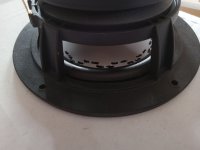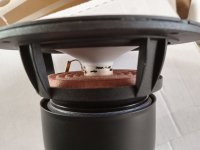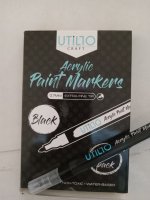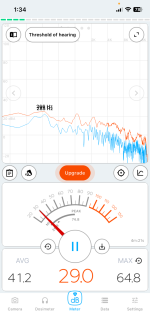We discussed previously whether or not EnABL would improve a MAOP driver, and I volunteered my MAOP-7 to try it. Sorry, couldn't do it earlier. Preparations for winter occupied most of my time - I live in a countryside.
First, I tried to do tap test to determine optimal positions of the patterns. It didn't work - at any distance on the cone radius tap sound was the same. Tapping worked on a 4" Sony speaker with a paper cone, I could find positions where tap produced the loudest sound. I guess the MAOP cone is pretty well-damped as-is. Without tap test guidance, I decided to apply patterns 1) close to surround; 2) on former close to cone boundary, and 3) on top of the dome. See pictures for details.
The patterns were applied free-hand using extra fine Utilto acrylic paint markers, black and white. Surround pattern was applied to back side of the cone to conceal my ugly handiwork. To build up thickness (pens lay paint pretty thin), three layers were applied: black-white-black. On the cap, a single layer of white.
The difference showed on the first test record, Beatrice Rana Chopin Preludes. This is a very well recorded piano album. The second prelude is played between piano and pianissimo. Control untreated driver played soft, but with the EnABLed driver I could hear string buzz that wasn't apparent before. Those familiar with the sound of top level instruments like Steinway or Fazioli will understand what I am talking about.
Further testing is unnecessary. It worked.
First, I tried to do tap test to determine optimal positions of the patterns. It didn't work - at any distance on the cone radius tap sound was the same. Tapping worked on a 4" Sony speaker with a paper cone, I could find positions where tap produced the loudest sound. I guess the MAOP cone is pretty well-damped as-is. Without tap test guidance, I decided to apply patterns 1) close to surround; 2) on former close to cone boundary, and 3) on top of the dome. See pictures for details.
The patterns were applied free-hand using extra fine Utilto acrylic paint markers, black and white. Surround pattern was applied to back side of the cone to conceal my ugly handiwork. To build up thickness (pens lay paint pretty thin), three layers were applied: black-white-black. On the cap, a single layer of white.
The difference showed on the first test record, Beatrice Rana Chopin Preludes. This is a very well recorded piano album. The second prelude is played between piano and pianissimo. Control untreated driver played soft, but with the EnABLed driver I could hear string buzz that wasn't apparent before. Those familiar with the sound of top level instruments like Steinway or Fazioli will understand what I am talking about.
Further testing is unnecessary. It worked.
Attachments
You're certainly braver than I would be. Good idea applying a pattern to the backside of the cone.
jeff
jeff
Very smart to use acrylic markers - seems much easier than the whole nib / acrylic paint thing. And multiple applications would allow to differentiate dot size & thickness when applying multiple rings. I'm inspired to do some testing with these myself (0.7mm): https://www.posca.com/en/product/pc-1mr/
Sigh. When is anyone going to provide data on EnABL? Bottom line is I'm not going to try that on any of my loudspeakers, even the cheep ones, just because someone on the internets says a piano prelude sounds buzzy like a piano should. Op, you had the perfect opportunity to show that EnABLE does anything at all. I'm glad you have $374 to try this out at home on your own speakers but you missed an opportunity that few of us can afford, and now all we have is another opinion that testing is unnecessary?
I literally have a dozen cheap speakers from the opportunity shop I could try but I don't know where to draw on them exactly or why to mark them in one place as opposed to another place.
@deanznz
I have a pair of Alpair 10.3s and I'm waiting for Dave's templates to point to the appropriate radii. Evidently the locations are determined by where the cone's curve changes or inflects but it's not clear to me how I would zero in on this.
the pattern of dashes is set and uniform across drivers... as I understand it.
I have a pair of Alpair 10.3s and I'm waiting for Dave's templates to point to the appropriate radii. Evidently the locations are determined by where the cone's curve changes or inflects but it's not clear to me how I would zero in on this.
the pattern of dashes is set and uniform across drivers... as I understand it.
Arthur - I am open to suggestions. If you have test tracks in mind, I will listen and report. Still keep the second driver in its original form.
The piano sound may need better qualification. The lowest 2 octaves of top tier instruments have high harmonics whose levels increase as a key is stricken harder. These harmonics sound somewhat like harpsichord. With a very gentle stroke these higher harmonics almost disappear. Almost, but not completely. It is an example of micro-detail. EnABL made it possible to hear this micro-detail.
The piano sound may need better qualification. The lowest 2 octaves of top tier instruments have high harmonics whose levels increase as a key is stricken harder. These harmonics sound somewhat like harpsichord. With a very gentle stroke these higher harmonics almost disappear. Almost, but not completely. It is an example of micro-detail. EnABL made it possible to hear this micro-detail.
If one follows the body of discussion about EnABL, It does NOT change measured speaker characteristics.
Any good recording will do fine. Record the response before EnABLE and record the response after. Then compare the responses to each other and to the source file. I'm mostly interested in frequency and phase but other tests will be fine. Square waves would be interesting. The testing may require multiple playback and recording sets to get an average of the EnABLE effect. Those that say it's too subtle to be measured are just dancing around the truth. The ability to measure things to the billionths is widely available these days. It should be repeatable. One thing that annoys me is testing labs that take one measurement of the frequency response and say, That's it!. No that's not it, do it again, repeat, ... If you are hearing a 'micro detail' it should be able to be measured. Recording, playback, and measuring equipment is far more accurate and precise than the human ear and the animal brain. (This brings up a topic all it's own, since we live in a digital world with digitally augmented speakers, maybe we need better testing to see how the sound is affected? I'm astounded by people who put lots of digital sound 'effects' in the signal chain and think it's great.)Arthur - I am open to suggestions. If you have test tracks in mind, I will listen and report. Still keep the second driver in its original form.
The piano sound may need better qualification. The lowest 2 octaves of top tier instruments have high harmonics whose levels increase as a key is stricken harder. These harmonics sound somewhat like harpsichord. With a very gentle stroke these higher harmonics almost disappear. Almost, but not completely. It is an example of micro-detail. EnABL made it possible to hear this micro-detail.
Your listening tests are pointless to us. While interesting, they are your opinion and backed up by nothing but maybe some previous reviews. After many hours of putting dots on expensive speakers you may be somewhat biased towards the success of your paint job. Don't take this personally, it happens to all of us, we are, technically, animals and have strong emotions. Beware, pretty soon we will be able to ask AI if it's audible, and you may not like the answer.
My guess as to what is happening: The EnABLE treatment is damping some responses and possibly allowing other responses. The EnABLE is taking away the noise and distortion and allowing the other sounds to playback at normal levels. At worst it is altering the frequency response and people are hearing the new slightly altered sound as better, in reality it's just different. I don't think there is anything magical going on here and that's what I would like to isolate, what is in fact happening? Once the effect is isolated and understood the EnABLE process should be repeatable to high precision during manufacturing, or by DIYers with something better than a tap test and an acrylic pen.
What you are asking I cannot do. I don't have anechoic chamber or Klippel machine. I also have no desire to repeat what others (more sophisticated than me in those things) tried and failed. Even if I possessed the right equipment, I don't believe that measurements alone can unequivocally predict the subjective sound. But I also respect positions of those who believe otherwise. Mark Fenlon, BTW, also doesn't believe in EnABL.
Case to the point: Pluvia Seven and MAOP-7 are the same driver with the exception of cone treatment. They have similar frequency response. The sound is different though, as recognized by those who don't regret paying 4x the price for the MAOP.

Case to the point: Pluvia Seven and MAOP-7 are the same driver with the exception of cone treatment. They have similar frequency response. The sound is different though, as recognized by those who don't regret paying 4x the price for the MAOP.
Re. digitizing at hi-rez and comparing, I've heard such comparisons and read opinions of others. Glaring discrepancies alone, such tests are inconclusive. They also critically depend on the transducers used in the test, and my speakers sound better to me than my headphones.
I'm not anti-EnABLE, I just think there should be some data to verify the improvement. Those that say the improvement is too subtle to be measured are kidding themselves.What you are asking I cannot do. I don't have anechoic chamber or Klippel machine. I also have no desire to repeat what others (more sophisticated than me in those things) tried and failed. Even if I possessed the right equipment, I don't believe that measurements alone can unequivocally predict the subjective sound. But I also respect positions of those who believe otherwise. Mark Fenlon, BTW, also doesn't believe in EnABL.
Case to the point: Pluvia Seven and MAOP-7 are the same driver with the exception of cone treatment. They have similar frequency response. The sound is different though, as recognized by those who don't regret paying 4x the price for the MAOP.
Very few of us live in a house quiet enough to perform serious measuring or even listening. Some people have very good studios or home theaters though. My house is extremely noisy with it's antique geo-thermal heat pump, jeeze it makes a lot of noise! It looks really steam punk. It's really efficient though and I recommend geo for anyone building a new house. For me to measure I usually get up at zero dark thirty before the roosters and sun get up, then I can measure outside, and it's really quiet. The background noise in my house to include my chef wife, dog, cat, plumbing, and AC is well beyond the subtleties of EnABLE and probably MAOP. One of the things I've found while being an audiophile, of sorts, is that silence is hard to achieve.
I agree that we haven't figured out how to measure everything yet. Dynamic range is one example. It's really great to listen to a live un-amplified performance on acoustic instruments. The softness to loudness can be shocking in a live performance.
@Arthur Jackson
just curious... how did you orient your geothermal collector pipes, horizontally or vertically?
there's a lot to be said for building a sound proof sound room for critical listening (for maximum enjoyment of course). you can get reasonable results with standard techniques. twenty years ago I helped build a large-ish sound booth for vocal recordings in an old old house... in the basement... beside a huge hot water boiler... 50 yards away from a streetcar route. we made some pretty clean recordings.
just curious... how did you orient your geothermal collector pipes, horizontally or vertically?
there's a lot to be said for building a sound proof sound room for critical listening (for maximum enjoyment of course). you can get reasonable results with standard techniques. twenty years ago I helped build a large-ish sound booth for vocal recordings in an old old house... in the basement... beside a huge hot water boiler... 50 yards away from a streetcar route. we made some pretty clean recordings.
I am blessed to live on wooded lot deep in the countryside. Clean power from individual distribution transformer. No noise, but on summer nights I need window fan for cold outside air, and on winter nights fireplace insert fan for heating. No music or alcohol during daytime.
I think that audio subtleties should not be judged using traditional tests such as FR, HD, IMD, spectrum decay, etc. The problem here is causality: If there are significant differences between drivers, it is impossible to tell whether such differences are responsible for the perceived effects, or they are just superfluous, Nor they should be judged using arbitrary music tracks, as this is subjective. Special listening tests must be designed that provide either quantitative or yes/no answers.
Here is one of such tests that I've read about a while ago. A stereo recording was made of fog horns in San Francisco Bay and played back through the same amplifier with switchable negative feedback loop. Listeners were given a task to count the number of different horns based on their timbres, directions, and levels. It was established that the numbers were significantly higher with feedback loop off. Maybe I should go to SF on a foggy day and do my own recording. I have a pair of modded Oktava mikes and a hi-rez digitizer.
I think that audio subtleties should not be judged using traditional tests such as FR, HD, IMD, spectrum decay, etc. The problem here is causality: If there are significant differences between drivers, it is impossible to tell whether such differences are responsible for the perceived effects, or they are just superfluous, Nor they should be judged using arbitrary music tracks, as this is subjective. Special listening tests must be designed that provide either quantitative or yes/no answers.
Here is one of such tests that I've read about a while ago. A stereo recording was made of fog horns in San Francisco Bay and played back through the same amplifier with switchable negative feedback loop. Listeners were given a task to count the number of different horns based on their timbres, directions, and levels. It was established that the numbers were significantly higher with feedback loop off. Maybe I should go to SF on a foggy day and do my own recording. I have a pair of modded Oktava mikes and a hi-rez digitizer.
Last edited:
That's incredible. Don't take this as sexist but I can only approach that when my wife goes away. Then I have to turn everything off, heater, fireplace, refrigerator, ...
No collector pipes, I have a well. I have two pipes one goes up one goes down. In the winter I pump the slightly colder water back into the ground, in the summer I use the AC waste water to water my trees, it works well. It pre-heats my hot water tank too.@Arthur Jackson
just curious... how did you orient your geothermal collector pipes, horizontally or vertically?
there's a lot to be said for building a sound proof sound room for critical listening (for maximum enjoyment of course). you can get reasonable results with standard techniques. twenty years ago I helped build a large-ish sound booth for vocal recordings in an old old house... in the basement... beside a huge hot water boiler... 50 yards away from a streetcar route. we made some pretty clean recordings.
I have a listening room where it is pretty quiet, fiberglass on the walls, extra carpet. I picked a room in our house that is far away from the heater and kitchen. It works well but in no way is as quiet as @norman bates listening room. I could probably come close to those levels in the fall after the apples have been harvested and before the heater becomes active. I live in an area surrounded by farms, farms aren't as quiet as everyone thinks.
- Home
- Loudspeakers
- Full Range
- EnABL-ing MAOP7




